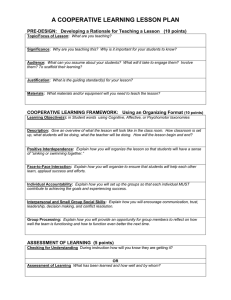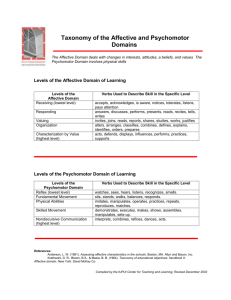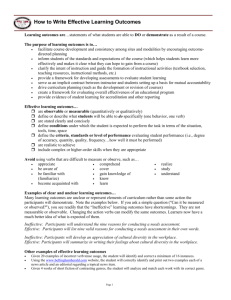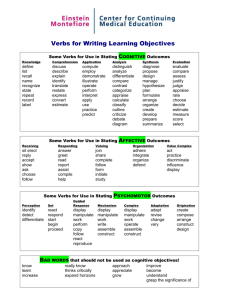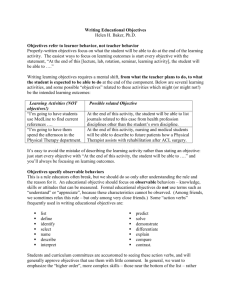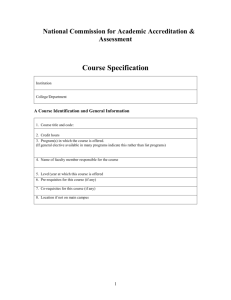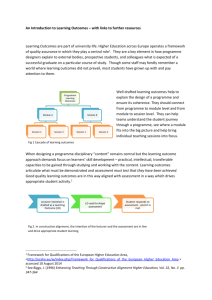What Drives Statements of Learning: Active Verbs
advertisement
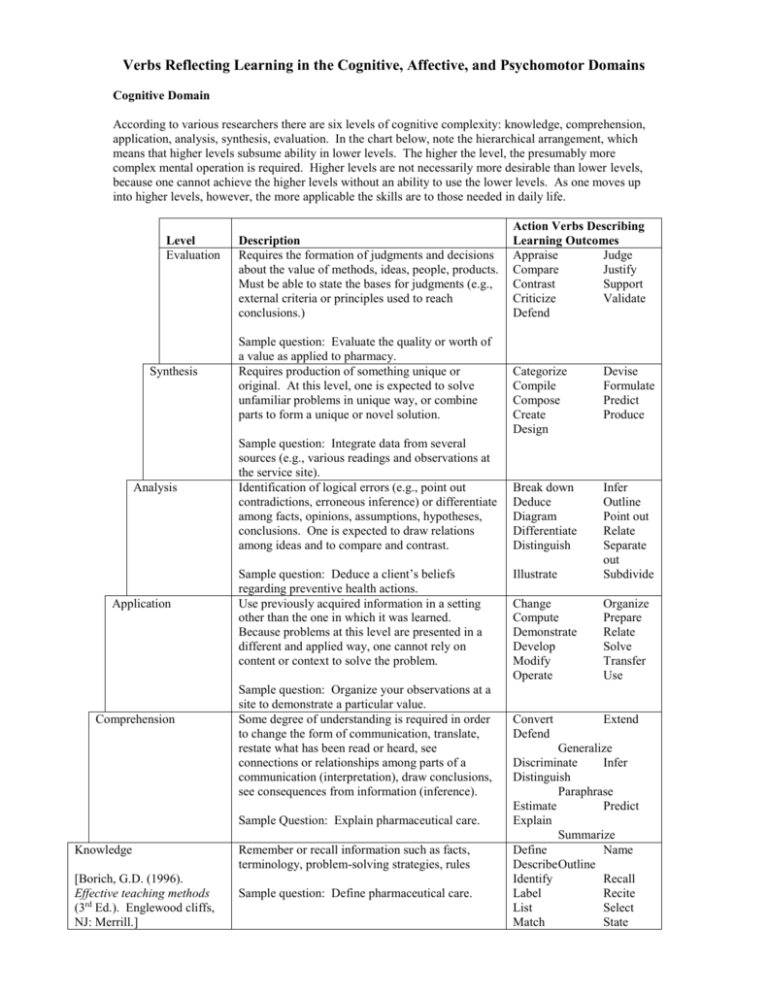
Verbs Reflecting Learning in the Cognitive, Affective, and Psychomotor Domains Cognitive Domain According to various researchers there are six levels of cognitive complexity: knowledge, comprehension, application, analysis, synthesis, evaluation. In the chart below, note the hierarchical arrangement, which means that higher levels subsume ability in lower levels. The higher the level, the presumably more complex mental operation is required. Higher levels are not necessarily more desirable than lower levels, because one cannot achieve the higher levels without an ability to use the lower levels. As one moves up into higher levels, however, the more applicable the skills are to those needed in daily life. Level Evaluation Synthesis Analysis Application Comprehension Description Requires the formation of judgments and decisions about the value of methods, ideas, people, products. Must be able to state the bases for judgments (e.g., external criteria or principles used to reach conclusions.) Sample question: Evaluate the quality or worth of a value as applied to pharmacy. Requires production of something unique or original. At this level, one is expected to solve unfamiliar problems in unique way, or combine parts to form a unique or novel solution. Sample question: Integrate data from several sources (e.g., various readings and observations at the service site). Identification of logical errors (e.g., point out contradictions, erroneous inference) or differentiate among facts, opinions, assumptions, hypotheses, conclusions. One is expected to draw relations among ideas and to compare and contrast. Sample question: Deduce a client’s beliefs regarding preventive health actions. Use previously acquired information in a setting other than the one in which it was learned. Because problems at this level are presented in a different and applied way, one cannot rely on content or context to solve the problem. Sample question: Organize your observations at a site to demonstrate a particular value. Some degree of understanding is required in order to change the form of communication, translate, restate what has been read or heard, see connections or relationships among parts of a communication (interpretation), draw conclusions, see consequences from information (inference). Sample Question: Explain pharmaceutical care. Knowledge [Borich, G.D. (1996). Effective teaching methods (3rd Ed.). Englewood cliffs, NJ: Merrill.] Remember or recall information such as facts, terminology, problem-solving strategies, rules Sample question: Define pharmaceutical care. Action Verbs Describing Learning Outcomes Appraise Judge Compare Justify Contrast Support Criticize Validate Defend Categorize Compile Compose Create Design Devise Formulate Predict Produce Break down Deduce Diagram Differentiate Distinguish Illustrate Infer Outline Point out Relate Separate out Subdivide Change Compute Demonstrate Develop Modify Operate Organize Prepare Relate Solve Transfer Use Convert Defend Extend Generalize Discriminate Infer Distinguish Paraphrase Estimate Predict Explain Summarize Define Name Describe Outline Identify Recall Label Recite List Select Match State Affective Domain Like the cognitive domain, the affective domain is hierarchical with higher levels being more complex and depending upon mastery of the lower levels. With movement to more complexity, one becomes more involved, committed, and self-reliant. Note the parallel between external and internal motivation. As one moves from being externally to internally motivated, one moves to higher levels. Level Characterization Organization Valuing Responding Receiving Description All behavior displayed is consistent with one’s value system. Values are integrated into a pervasive philosophy that never allows expressions that are out of character with those values. Evaluation at this level involves the extent to which one has developed a consistent philosophy of life (e.g., exhibits respect for the worth and dignity of human beings in all situations). Commitment to a set of values. This level involves 1) forming a reason why one values certain things and not others, and 2) making appropriate choices between things that are and are not valued. One is expected to organize likes and preferences into a value system and then to decide which ones will be dominant. Display behavior consistent with a single belief or attitude in situations where one is neither forced or asked to comply. One is expected to demonstrate a preference or display a high degree of certainty and conviction. One is required to comply with given expectations by attending or reacting to certain stimuli. One is expected to obey, participate, or respond willingly when asked or directed to do something. One is expect to be aware of or to passively attend to certain stimuli or phenomena. Simply listening and being attentive are the expectations. Action Verbs Describing Learning Outcomes Avoid Display Exhibit Internalize Manage Require Resist Resolve Revise Abstract Formulate Balance Select Compare Systemize Decide Theorize Define Act Argue Convince Debate Display Express Help Organize Prefer Applaud Participate Comply Play Discuss Practice Follow Volunteer Obey Attend Listen Be aware Look Control Notice Discern Share Hear Psychomotor Domain This domain is given primarily for information. Other courses within the curriculum stress this various levels of psychomotor performance (e.g., Clinical Skills Laboratory, Pharmacy Practice I). Psychomotor behaviors are performed actions that are neuromuscular in nature and demand certain levels of physical dexterity. Level Naturalization Articulation Precision Manipulation Imitation Description High level of proficiency is necessary. The behavior is performed with the least expenditure of energy, becomes routine, automatic, and spontaneous. Requires the display of coordination of a series of related acts by establishing the appropriate sequence and performing the acts accurately, with control as well as with speed and timing. Requires performance of some action independent of either written instructions or a visual model. One is expected to reproduce an action with control and to reduce errors to a minimum. Performance of an action with written or verbal directions but without a visual model or direct observation. The action may be performed crudely or without neuromuscular coordination at this stage. Notice that the action verbs are the same as those for the imitation stage. The difference is that these actions are performed with the aid of written and verbal instruction, not visual demonstration. The learner observes and then imitates an action. These behaviors may be crude and imperfect. The expectation that the individual is able to watch and then repeat an action. Action Verbs Describing Learning Outcomes Automatically Spontaneously Effortlessly With ease Naturally With perfection Professionally With poise Routinely Confidence Smoothness Coordination Speed Harmony Stability Integration Timing Proportion Accurately Proficiently Errorlessly With balance Independently With control Align Balance Follow Grasp Hold Place Repeat Rest (on) Step (here) Align Balance Follow Grasp Hold Place Repeat Rest (on) Step (here)
